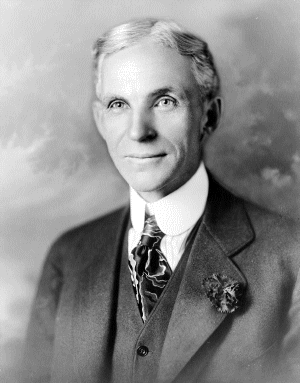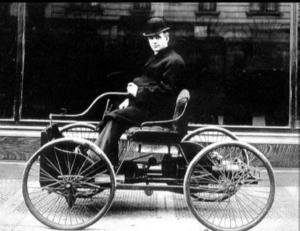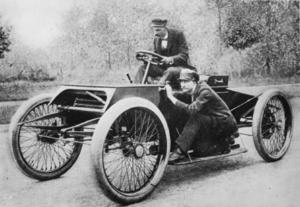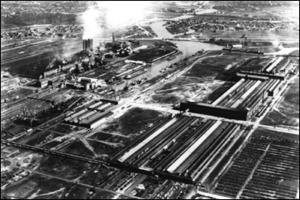 SKC Films Library SKC Films Library |
| SKC Films Library >> Economics >> Mechanical Industries |
| Henry Ford car company founder Henry Ford was born on a farm in what is now Dearborn, Michigan, on July 30, 1863. Although he never cared for farming, he was from an early age very handy with farm machinery. He developed a reputation for being able to fix a variety of farm implements, and, at the age of 15, he even built his own steam engine. In 1879 Ford left the farm and moved to Detroit, where he became a machine-shop apprentice at the Detroit Edison Company. After three years he returned to Dearborn, where he spent the next few years operating and repairing steam engines, working in a Detroit factory, overhauling his father's farm implements, and occasionally working on the family farm. He married Clara Bryant in 1888, and the couple's only child, Edsel Bryant, was born in 1893. In 1891 he became an engineer for the Edison Illuminating Company, and became its chief engineer in 1893.
The Ford Motor Company Ford's first venture into the world of automobiles came in 1893, when he built an internal combustion, one-cylinder gasoline engine. His first actual automobile was the Quadricycle, which he built in 1896. It was a self-propelled, four-wheeled vehicle that was steered with a tiller and had only two forward speeds. In 1899, he left Edison to run the Detroit Automobile Company, which produced only a few cars a day at a factory on Mack Avenue in Detroit. Here, groups of two or three men worked on each car from components made to order by other companies. Each group was responsible for producing one car at a time, a very expensive and inefficient process. Ford wanted to incorporate the use of standardized parts and an assembly line process to make the production line more efficient, but his bosses disagreed. Henry Ford with his Quadricycle A desire to produce cars more efficiently led Ford to quit Detroit in 1901 and organize the Henry Ford Company, with himself as chief engineer. Disputes with his financial bankers led him to resign in 1902, after which the company became the Cadillac Motor Company. Still having trouble convincing financial backers that he could manufacture a good quality car at a far cheaper price than his competitors, Ford began building race cars. He then challenged other manufacturers to race their cars against his. His successes proved his concept, and in 1903 he was able to obtain enough capital to establish the Ford Motor Company. The first Model A was sold to a local doctor on July 20, 1903, and an automotive institution was born. Henry Ford racing one of his cars,
1901 Ford introduced the Model T in 1908. Easy to operate, maintain, and handle, the car sold for $850, almost half the cost of other cars of the day. The Model T proved successful from the beginning, and by 1915 Ford had managed to reduce the production costs so much that he was able to lower the price to $290. By the time the last Model T rolled off the assembly line in 1927, some 15 million of them had been sold. In 1910, Ford opened a large factory in Highland Park, Michigan, that finally realized his dream of combining precision manufacturing with standardized and interchangeable parts and a clear division of labor. The moving assembly line was added in 1913. In 1914, in order to attract and keep the best workers, Ford increased base pay from $2.50 to $5.00 per day and reduced the work day from 9 to 8 hours. In 1917, Ford began construction of the Rouge River Plant. The largest industrial complex in the world at the time, the complex would eventually include a steel mill, glass factory, and automobile assembly line. Virtually everything required to build and assemble a Model T was manufactured on the premises. The final assembly line was transferred from Highland Park in 1927. In 1930, the Rogue River Plant covered 6,952,484 square feet and employed 81,000 men. Labor Relations Although Henry Ford believed in treating his workers well and rewarding them for jobs well done, he was a vehement opponent of labor unions and worked hard to keep the United Auto Workers from unionizing his plants. A 1937 "battle" between Ford security staff and United Auto Workers organizers, however, resulted in a court order barring Ford from interferring with union activity. He finally agreed to a contract with the UAW in 1941. Ownership and Management Despite the success of his Model T, Ford was almost always at odds with his financial backers. Ford usually solved these disputes by simply buying out individual investors, and by 1919 he and his son had majority ownership of the company. Edsel Ford became president of Ford Motor Company that same year, a position he held until his death in 1943; Henry Ford succeeded his son as president, but turned the job over to his grandson, Henry Ford II, in 1945. Other Activities In 1905, Ford served as the first vice president of the Society of Automotive Engineers, an organization he helped found for the purpose of introducing standardized parts to the automotive industry in general. In 1915, Ford and about 170 others went to Europe in hopes of ending World War I; they were unsuccessful. In 1918, Ford made an unsuccessful bid for the U.S. Senate. Although he never ran for another political office, he was always very outspoken on political subjects of his day. An early promoter of the use of aviation technology, he helped develop the Tri-Motor airplane in 1926. In 1929, Ford dedicated the Edison Institute of Technology and Greenfield Village. The Village was a sort of living museum in rural Michigan that featured a series of small factories where people could work and farm during different seasons. The Institute conducted research into the use of agricultural products in industrial production, including soybean-based plastic automobile components. During World War II, Ford gained a reputation for being anti-Semitic due to his criticism of Jews and his apparent tolerance of German nationalism. Henry Ford died at Fair Lane, his Dearborn home, on April 7, 1947. SOURCES SEE ALSO |
| SKC Films Library
>> Economics >> Mechanical Industries This page was last updated on June 05, 2017. |






